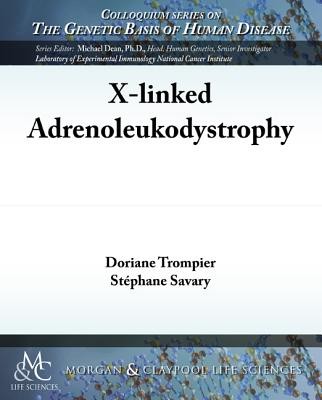
- We will send in 10–14 business days.
- Author: Doriane Trompier
- Publisher: MORGAN & CLAYPOOL
- ISBN-10: 1615045546
- ISBN-13: 9781615045549
- Format: 19.1 x 23.5 x 0.7 cm, minkšti viršeliai
- Language: English
- SAVE -10% with code: EXTRA
Reviews
Description
X-linked adrenoleukodystrophy (X-ALD) is the most common leukodystrophy and the most frequent peroxisomal disorder, with an estimated incidence of 1:17,000. This complex neurodegenerative disorder is characterized by a huge clinical variability both in the age of onset and in symptoms. The two main forms are the childhood cerebral ALD (ccALD) characterized by inflammatory demyelination of the central nervous system, and the adult form called adrenomyeloneuropathy (AMN), characterized by a non-inflammatory slowly progressive demyelination affecting spinal cord and peripheral nerves. Adrenal insufficiency is usually associated with the nervous symptoms, X-ALD being the main cause of Addison's disease. The main biochemical defect is the accumulation of very-long-chain fatty acids (VLCFA, fatty acids with a chain length of more than 22 carbon atoms), particularly in the cholesterol ester fraction of the adrenal gland and brain white matter. X-ALD is associated with mutations in the ABCD1 gene, which encodes for a peroxisomal ATPBinding Cassette (ABC) transporter predicted to allow VLCFA-CoA to enter into the peroxisome for their ?-oxidation. In spite of animal models, the physiopathogenesis of the disease remains poorly understood. However, several therapeutic strategies have been investigated. Among them, allogeneic bone marrow transplantation has proven effective and, more recently, the first gene therapy trial ended with a resounding success.
EXTRA 10 % discount with code: EXTRA
The promotion ends in 22d.05:15:30
The discount code is valid when purchasing from 10 €. Discounts do not stack.
- Author: Doriane Trompier
- Publisher: MORGAN & CLAYPOOL
- ISBN-10: 1615045546
- ISBN-13: 9781615045549
- Format: 19.1 x 23.5 x 0.7 cm, minkšti viršeliai
- Language: English English
X-linked adrenoleukodystrophy (X-ALD) is the most common leukodystrophy and the most frequent peroxisomal disorder, with an estimated incidence of 1:17,000. This complex neurodegenerative disorder is characterized by a huge clinical variability both in the age of onset and in symptoms. The two main forms are the childhood cerebral ALD (ccALD) characterized by inflammatory demyelination of the central nervous system, and the adult form called adrenomyeloneuropathy (AMN), characterized by a non-inflammatory slowly progressive demyelination affecting spinal cord and peripheral nerves. Adrenal insufficiency is usually associated with the nervous symptoms, X-ALD being the main cause of Addison's disease. The main biochemical defect is the accumulation of very-long-chain fatty acids (VLCFA, fatty acids with a chain length of more than 22 carbon atoms), particularly in the cholesterol ester fraction of the adrenal gland and brain white matter. X-ALD is associated with mutations in the ABCD1 gene, which encodes for a peroxisomal ATPBinding Cassette (ABC) transporter predicted to allow VLCFA-CoA to enter into the peroxisome for their ?-oxidation. In spite of animal models, the physiopathogenesis of the disease remains poorly understood. However, several therapeutic strategies have been investigated. Among them, allogeneic bone marrow transplantation has proven effective and, more recently, the first gene therapy trial ended with a resounding success.


Reviews